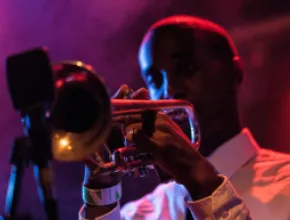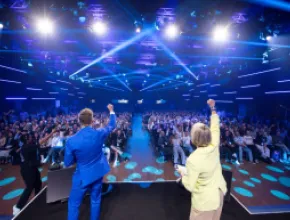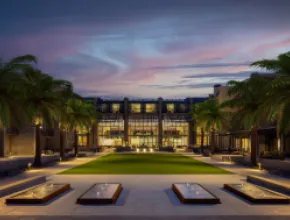Rewind the calendar 150 years and few places in the country were more exciting than Illinois. The U.S. was just getting on its feet with commerce, settlers were moving westward and, in the process, building railroad lines, theaters, hotels and homes all over the state. The brightest and the best came through Illinois (many stayed), including architects, politicians (Abraham Lincoln and Ulysses S. Grant, to name a few) and a number of famous business leaders (Marshall Field and others).
Each one of these visionaries left their mark on the beautiful land that is still thriving today. Fortunately for those us living in current times, a plethora of historic venues have been restored and are open to group events. Here, we highlight a few standouts that are guaranteed to transport you back in time.
Chicagoland
A visit to Chicago isn’t complete without an architectural boat cruise down the Chicago River. There are several companies that offer such experiences, but cruises run by the Chicago Architecture Foundation are among the most popular. This year marks the foundation’s 20th year on the water. Cruises are offered May through mid-November and run about 90 minutes. During that time, visitors listen to docents explain little-known features of new and old buildings lining the river.
The cruise is open to the public and groups of up to 250 guests. While on the boat, try to spot the Ferris wheel at Navy Pier. Did you know the world’s first Ferris wheel was showcased at the World Columbian Exposition in Chicago in 1983?
A short walk south will land groups at the entrance to the 1,629-room Palmer House, A Hilton Hotel, the longest continuously running hotel in the country, having opened in 1871 by business magnate Potter Palmer. The original structure burned down during the Great Chicago Fire and was rebuilt by Palmer as the “world’s first fire-proof building,” says Ken Price, director of public relations and official historian for the property.
The current, 24-story structure was built in 1924 and has a ceiling comprising 21 paintings reminiscent of the Sistine Chapel, a nod to Bertha Palmer’s (Potter’s wife) love of European artwork. The hotel is famous for holding legendary banquets. (One, hosted by Mark Twain in 1879, welcomed President Ulysses S. Grant home from a trip abroad). Meeting planners can continue the tradition by holding meetings in the property’s more than 100,00 square feet of group gathering space.
As an extra bonus, delegates can visit the hotel’s new (opened in April) on-site museum for a look at artifacts from the past.
Located south of Chicago in the city of Crete is Balmoral Park, a year-around horse racing facility with a rich history. Former Churchill Downs manager Col. Matt J. Winn built the track in 1926. It operated under the name Lincoln Fields until 1955.
The facility can accommodate groups of up to 10,000 in its Balmoral Club Dining Room with a perfect view of the racetrack. While on site, meeting planners can organize special race dedications for groups, photos in the Winner’s Circle and rides in a start car. PageBreak
Northern Illinois
The late 1920s and early 1930s were high times for the introduction of movie houses and Vaudeville acts. Groups looking to take a step back in history can travel up to Waukegan for an event at the Genesee Theatre. The breathtaking facility was built in 1927 as a place for Vaudeville acts and quickly transitioned to a movie house.
“In the 1950s, we housed two world premieres, one for Man About Town and another for The Navy Way,” says Fay Ander, special events manager at the Genesee. “Coming to the Genesee was truly a fancy night out.”
But as cinema multiplexes became popular, the Genesee lost its appeal to the public. It closed in 1989 and sat vacant for 10 years until the city of Waukegan purchased it in 1999 and broke ground two years later on a $23 million renovation.
“We reopened in 2004 with two sold-out Bill Cosby shows,” Ander says.
The theater was restored to its original splendor during the renovation and today showcases an ornate Spanish Renaissance style with gold and silver tones. A crystal chandelier hangs in the center of the lobby at 18 feet high and weighing 2,200 pounds. Groups frequent the theater with its more than 2,400-seat auditorium and seven lounges—perfect for breakout sessions.
In the mid 19th century, there were few hotel openings more exciting than that of the DeSoto House Hotel in Galena. At the time, the city was thriving and attracting westward travelers, business magnates and political leaders. Dubbed the “Largest Hotel in the West,” it opened with 225 guest rooms in 1855. Its luxurious furnishings and superior service brought in the biggest names of the time. One year after opening, President Abraham Lincoln spoke from a hotel balcony and later Ulysses S. Grant used the hotel as headquarters for his presidential campaign.
Over the years, though, the property fell into disrepair. After a major renovation in the late 1980s, it rose again to national significance. Today, the hotel has 55 guest rooms, a ballroom that can accommodate up to 175 guests and six meeting rooms that can hold up to 100 people each. PageBreak
Central Illinois
Sitting in the center of Champaign is The Virginia Theatre, an opulent historic theater constructed in 1921.
“The Virginia was built as a Vaudeville house and movie palace,” says Steven Bentz, director of the theater. “We finished with a $7.5 million renovation in April and it is absolutely beautiful.”
The space is reminiscent of a European opera house with a striking honeycomb ceiling.
“Oh, I love the ceiling,” Bentz says. “It is such a historic feature. You don’t see a lot of those in this part of the state. The venue is brilliantly restored.”
Groups of up to 1,463 are welcome to meet in the auditorium and in the venue’s three lobby spaces.
Walking around historic Bloomington, it’s hard to miss the striking McLean County Museum of History, with its American Renaissance style architecture and hand-carved limestone.
“Walking into our museum will make any millionaire feel like their house was Xeroxed,” says Greg Koos, executive director of the museum. “The building is the old county courthouse and is absolutely stunning. Walk in to the rotunda and it will take your breath away.”
The structure was built in the early 1900s and is no longer a courthouse, but a 40,000-square-foot museum housing exhibits about the people of the county, a research library and a historic archive. The property contains more than 20,000 regional artifacts.
According to Koos, groups are welcome to rent out a former courtroom, which includes a judge’s bench and jury box. The space can seat up to 140 for lectures and 40 for board meetings. The Town of Normal Room, says Koos, is also an option and can seat 30 people lecture-style and 20 people boardroom-style.
Southern Illinois
Located on the campus of Southern Illinois University in Carbondale is Shryock Auditorium, an excellent option for groups looking to meet in a historic venue. The structure was built in 1917 and named after Henry William Shryrock, a former university president.
The venue is adorned with lavish Roman decor touches. It went through a large-scale renovation in the 1970s when a huge pipe organ was added, which now sits in its north balcony.
Today, Shryock Auditorium hosts university performances as well as business meetings, with 1,214 seats.
Katie Morell is a Chicago transplant living in San Francisco. Read more of her work at www.katiemorell.com






